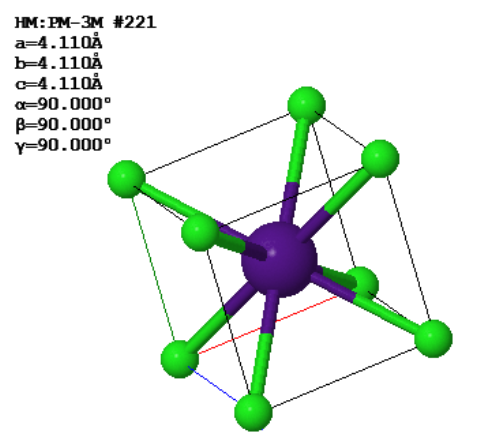
Name Matrikelnr.
Every subproblem (a), (b), (c), etc. is worth 3 points.
Problem 1
(a) Write down the total Hamiltonian for a helium atom ($Z=2$).
(b) What is the reduced Hamiltonian for helium? Why do we use the reduced Hamiltonian instead of the total Hamiltonian?
(c) Write down a two-electron wavefunction that solves the reduced Hamiltonian for helium. You can write this wavefunction in terms of the atomic orbitals.
(d) What is the exchange energy? How is it calculated?
Solution
Problem 2
The conventional unit cell of a CsCl crystal is shown below.

(a) What is the Bravais lattice of CsCl?
(b) What are the primitive reciprocal lattice vectors of CsCl?
(c) How many phonon normal modes are there in 1 cm³ of CsCl?
(d) How many optical branches are there in the phonon dispersion relation of CsCl?
(e) Express the phonon contribution to the specific heat as an integral including the phonon density of states.
Solution
Problem 3
(a) In a diffraction experiment, x-rays with wavevector $\vec{k}$ are directed at a crystal and x-rays with a wavevector $\vec{k}'$ are diffracted from the crystal. The wavelength of the incoming waves $\vec{k}$ is set by the x-ray source. What determines the wavelength of the diffracted waves $\vec{k}'$?
(b) How can the reciprocal lattice vectors be determined by measuring $\vec{k}'$?
(c) Suppose one hundred reciprocal lattice vectors have been measured. How could you use this data to determine something about the crystal structure?
(d) If you also recorded the intensity of each diffraction peak associated with the one hundred reciprocal lattice vectors, what could you determine with this information?
(e) What is the Ewald sphere?
Solution
Problem 4
A tight-binding calculation is performed for copper. Copper has 29 electrons in total with an electron filling of 1s22s22p63s23p63d104s1. The tight binding calculation only includes the five 3d atomic orbitals and the 4s atomic orbital.
(a) Write down the trial wave function that is used in this calculation.
(b) How many bands will be calculated?
(c) How would you calculate the chemical potential? Hint: the electron density you use to find the chemical potential depends on the number of atomic orbitals in the tight-binding wave function.
(d) Why do you need to calculate the chemical potential to determine if this is a metal, a semiconductor, or an insulator?
Solution